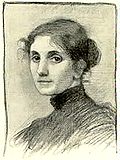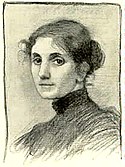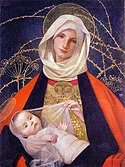Marianne Stokes
Marianne Stokes z domu Preindlsberger (ur. 1855 w Grazu, zm. 1927 w Londynie) – malarka pochodzenia austriackiego działająca we Francji i w Wielkiej Brytanii pod koniec epoki wiktoriańskiej.
Życie
Studiowała w Monachium i Paryżu m.in. u Pascala Dagnana-Bouvereta i Gustave Courtoisa. Początkowo mieszkała i tworzyła we Francji pod wpływem przyrodników francuskich takich jak Jules Bastien-Lepage i Jean-François Millet. Wspólnie w fińską malarką Helene Schjerfbeck w 1883 wyjechała do Pont-Aven w Bretanii, gdzie poznała przyszłego męża, brytyjskiego pejzażystę Adriana Scott Stokesa. Po ślubie w 1884 prowadziła z mężem wspólną karierę artystyczną, która trwała ponad 40 lat. Małżeństwo osiadło w St Ives w Kornwalii i często podróżowało po Europie m.in. do Austrii, Holandii i Słowacji.
Twórczość
Marianne Stokes miała pierwszą wystawę w Royal Academy w 1885, wystawiała też w Grosvenor Gallery, New Gallery i Royal Society of British Artists. W 1900 zorganizowała z mężem wspólną wystawę w Fine Art Society w Londynie. Wzięła też udział w Wystawie powszechnej w 1893 w Chicago, gdzie została nagrodzona medalem. Artystka była członkiem Newlyn School i członkiem Royal Society of Painters in Water Colours.
Malarka podejmowała szeroką tematykę od rustykalnych obrazów inspirowanych naturalistycznym malarstwem francuskim, po utrzymane w duchu prerafaelitów sceny biblijne, mitologiczne i ilustracje eposów średniowiecznych. Nadrzędnym tematem jej prac zawsze był człowiek.
Artystka posługiwała się początkowo techniką olejną, którą porzuciła na rzecz tempery i akwareli.
Szczególnie cenione przez etnografów są prace Stokes, które powstały podczas jej półrocznego pobytu w Zdziarze w 1905. Artystka namalowała wówczas kilkadziesiąt przedstawień słowackich kobiet w strojach ludowych. Prace te są dzisiaj cennym zapisem słowackiej kultury. Plonem tego wyjazdu była książka Węgry, która obok prac Marianne Stokes zawierała pejzaże jej męża.
Prace artystki eksponowane są m.in. w Tate Gallery w Londynie, Wallraf-Richartz-Museum & Fondation Corboud w Kolonii, w publicznych zbiorach i muzeach m.in. w Manchesterze i Wolverhampton[1][2].
Publikacje
- Hungary, Adrian and Marianne Stokes, (Adam and Charles Black, London, 1909), 75 colour full-page illustrations of Slovakia and High Tatra.
Przypisy
- ↑ Askart.com – biografia (ang.). [dostęp 2009-03-27].
- ↑ Wolverhampton Art & Museums (ang.). [dostęp 2009-03-27].
Literatura dodatkowa
- John Christian, Mary Anne Stevens: The Last romantics: the romantic tradition in British art, Burne-Jones to Stanley Spencer. London: Lund Humphries in association with Barbican Art Gallery, 1989. ISBN 0-85331-552-3.
Linki zewnętrzne
- Marianne Stokes w Artcyclopedia.com (ang.). [dostęp 2009-03-27].
- Artmagick.com – biografia i galeria (ang.). [dostęp 2009-03-27].
Media użyte na tej stronie
Autor: Marianne Stokes , Licencja: No restrictions
Identifier: hungary00stok
Title: Hungary
Year: 1909 (1900s)
Authors: Stokes, Adrian, 1854-1935 Stokes, Marianne
Subjects:
Publisher: London : A. and C. Black
Contributing Library: Robarts - University of Toronto
Digitizing Sponsor: University of Toronto
View Book Page: Book Viewer
About This Book: Catalog Entry
View All Images: All Images From Book
Click here to view book online to see this illustration in context in a browseable online version of this book.
Text Appearing Before Image:
in his light red summer coat. Nearer, ever nearer,came the hounds. The buck stepped down the edgeof the wood till opposite my place of concealment,then suddenly broke away, and, leaping over thestones and undergrowth between us, came on to hisfate. The guest of the day, a rubicund and jovialJudge, was on my left. Presently I heard himshoot twice, and then a second buck, going likethe wind, flashed between me and the wood. Myfirst barrel had no effect, but the second, aimedwell in front, bowled him head over heels, andhe lay dead. The Judge rushed up with out-stretched hand to clasp mine, and thank me forhaving stopped his quarry, and ask if it was stillgoing when I fired! As a matter of fact, it hadseen him when about to shoot, doubled back, andonly offered a long shot from behind, which couldhave had no effect but to accelerate its pace.However, some shot were found near its hind-quarters, and at the end of the day he carriedit off in triumph to Budapest. SLOVAK GIRL IN SUNDAY ATTIRE
Text Appearing After Image:
VAZSECZ AND LUCSIVNA-FURDO 73 The drive was over. Beaters and hounds drewnear, the guns assembled round a fire, and heartycompHments were paid to me. Then a hamperwas opened, wine and mineral waters were handedround, cigars lit, and one or other of the company-started snatches of old Hungarian hunting songs,the rest forming a chorus. After each drive, and whenever we stopped fora short rest or consultation, a fire was at oncemade by the beaters. They all smoked pipeswith small clay bowls closed with metal lids andstuffed with strong tobacco, which they hadpreviously moistened with saliva and rolled uptight in the palms of their hands. The heads ofthe pipes were then thrust among the glowingembers of the fire to roast, and afterwards thetobacco was lit in the usual way. This methodwas said to make it burn more slowly and tastestronger than any other known. Several outlying parts of the forest were driven,and a few hares fell before we arrived at the shedwhere luncheon was prepared, but
Note About Images





